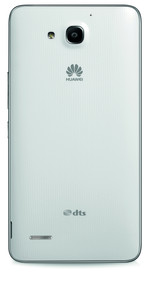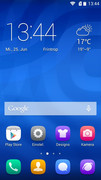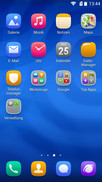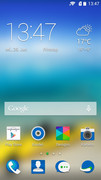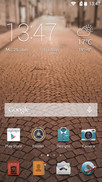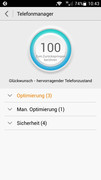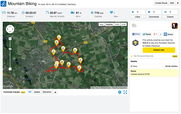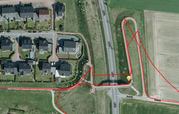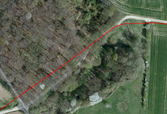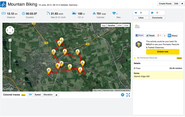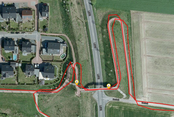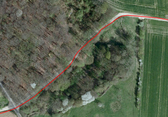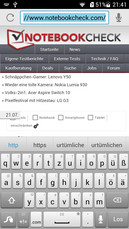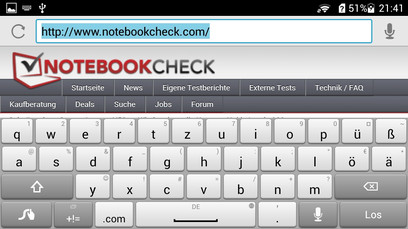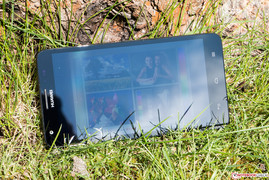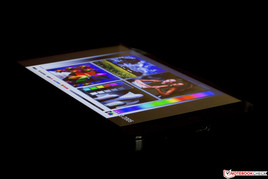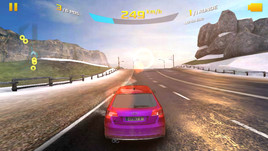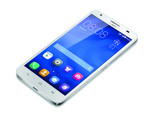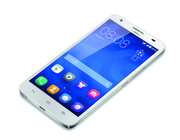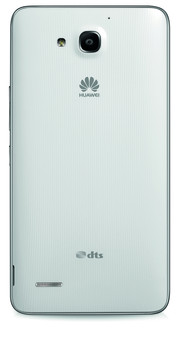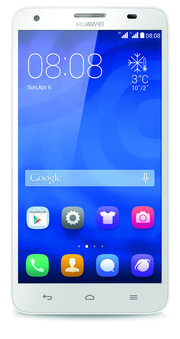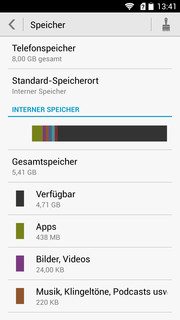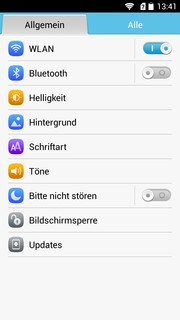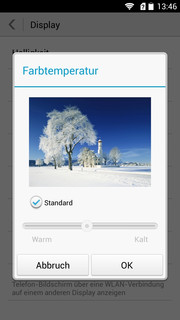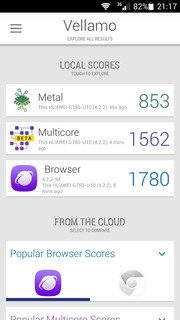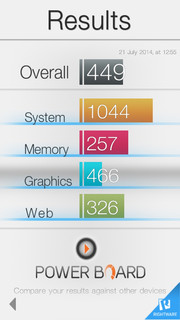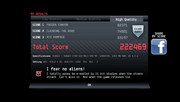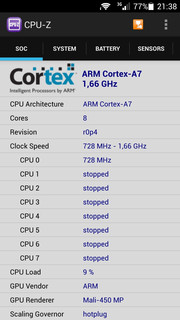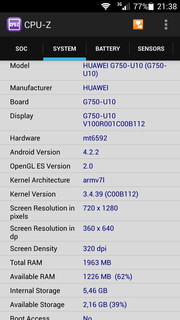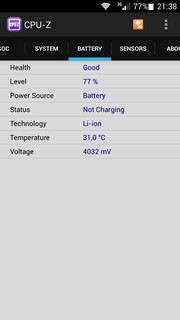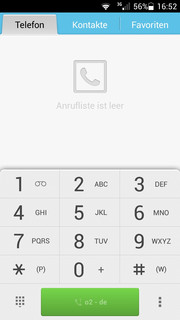Huawei Ascend G750 Smartphone Review

For the original German review, see here.
The Chinese manufacturer expands its mid-range product line with yet another device dubbed Ascend G750. The 5.5-inch touchscreen is the first thing noticed, and it has a considerably higher resolution than the smaller Ascend G730. Our review sample is not only superior in this regard but also features a stronger configuration in almost all other things. For example, a swift eight-core processor is installed, and the 8 GB flash memory is twice the size. Also, the battery's capacity of 3000 mAh is significantly more generous.
Dual-SIM contenders besides the LG G Pro Lite and Acer Liquid S1 are also smaller phones made in China, such as the Zopo ZP1000 or iOcean X7S. Users who do not need a second SIM slot will find an interesting offer in HTC's Desire 816.
Case
With a height of not quite nine millimeters, Huawei's Ascend G750 belongs to the slimmer members of this size category. The weight of 162 grams is not too heavy either. The plastic casing makes a very high-quality impression; the back features a leather-texture look in the black model. It feels good but attracts fingerprints magically. The big smartphone is comfortable to hold.
However, the G750's stiffness could be better. The smartphone is quite easy to twist without much effort, and that produces crackling noises inside. The device also responds to pressure almost immediately. Even more forceful inputs on the touchscreen cause a slight wave formation. Stronger pressure on the back leads to the same effect. The gaps are even and impeccable.
The phone's back can be removed and makes accessing the removable battery, both SIM slots, and the microSD slot possible.
Connectivity
Software
Huawei's G750 is powered by Google's Android 4.2.2 Jelly Bean and is complemented by Huawei's proprietary Emotion UI 2.0 user interface. It is available in three different designs. The preloaded software is kept within limits, and no bloatware is installed. Performance-intensive apps and a contact black list can be managed, the storage optimized, and the power settings adapted in the Phone Manager. The use of devices with Android Wear is not possible due to the older operating system version.
Communication & GPS
The communication options of Huawei's Ascend G750 are on an entry-level smartphone level and only offer the most necessary features. Besides quad-band GSM, dual-band HSPA for mobile data connections is installed. The latter only operates with a maximum download rate of up to 21 Mbps (upload: 5.76 Mbps). LTE is not at all available. Unlike the manufacturer specifies, 3G connections work with both SIM slots (1 micro and 1 mini SIM).
The Wi-Fi module supports the IEEE 802.11 b/g/n standards and consequently only transmits in the 2.4 GHz frequency range. The components' range is quite good, but the response times are sometimes a bit long even when standing next to the router. Bluetooth 4.0 is also available and functions perfectly.
The GPS receiver quickly finds a satellite outdoors and provides a really good connection quality. Unfortunately, this good impression cannot be extended to the accuracy in practical use. The deviations on our test route are even more obvious when compared with the Garmin Edge 500 bike GPS computer. Nevertheless, the module in the smartphone provides useful performance.
Telephony and Speech Quality
The phone app in Huawei's Ascend G750 is very neat and clearly arranged. It has only undergone subtle cosmetic modifications.
The phone's speech quality is very good on both sides when it is held to the ear. The speaker is not as convincing. The called contact stated slight distortions alongside short interruptions. Our contact sounded tinny, and high pitches were piercing. The included headset provided a decent performance on both sides and proved very useful.
Cameras and Multimedia
Huawei's Ascend G750 features two high-resolution cameras. The front-facing lens has a resolution of up to 5 MP (2560x1920 pixels, 4:3) and enables taking quite decent selfies. Various picture modes, such as beautifying or blurring, can assist in the presentation and adaptation of the photographed person.
The primary camera shoots pictures with a maximum of 13 MP (4160x3120 pixels; 4:3) and provides sharp pictures in good light. However, the color intensity could be a bit more saturated, but it is nevertheless appealing. The camera modes are even more extensive here and also allow taking panoramas or multi-angle pictures. HDR is also supported. The results in weak light look somewhat frayed. Although the LED flash is useful, it overexposes in close-ups. Basically, the user gets a good smartphone camera though.
Videos can be recorded in Full HD (1920x1080 pixels) with 30 fps and stereo sound.
Accessories
The accessories included for Huawei's Ascend G750 are comprised of a modular power supply with a power output of 5 watts (5 volts, 1 ampere), a USB cord, and a headset. The manufacturer does not offer any optional, smartphone-specific accessories.
Warranty
The manufacturer includes a 24-month warranty on its product that cannot be upgraded. A 6-month warranty is given for the included accessories and battery.
Input Devices and Controls
The 5.5-inch, capacitive touchscreen of Huawei's Ascend G750 supports up to five inputs at the same time. There are no complaints about the accuracy or response time of the touch-sensitive surface. The gliding properties are also really good and are convincing. Even the glove mode functions reliably.
The manufacturer's keyboard layout is well-conceived and adds a further comma button when text messages are entered. Although it can still be used with one hand in portrait mode, an additional one-hand operation mode can be optionally enabled in the settings. It slightly reduces the keyboard's size and allows moving it to the desired screen edge.
Display
The 5.5-inch screen of Huawei's Ascend G750 has a resolution of 1280x720 pixels. That corresponds to an aspect ratio of 16:9 and a pixel density of 267 ppi. The resolution will usually be sufficient, but a slight pixelation can be discerned when looking closer.
The screen's maximum brightness of 418 cd/m² is on a good level. The illumination of 85% could be a bit more homogeneous. However, that is not particularly disturbing in everyday use and is only seen on mono-colored surfaces. The Ascend G700 (max. 562 cd/m²; 92%) did a much better job here.
| |||||||||||||||||||||||||
Brightness Distribution: 85 %
Center on Battery: 412 cd/m²
Contrast: 792:1 (Black: 0.52 cd/m²)
ΔE ColorChecker Calman: 6.71 | ∀{0.5-29.43 Ø4.78}
ΔE Greyscale Calman: 6.6 | ∀{0.09-98 Ø5}
Gamma: 2.62
CCT: 8169 K
The black level of 0.52 cd/m² is within an acceptable range and lets black really look like black. The resulting contrast of 792:1 is quite good.
The color accuracy could certainly be better but is quite acceptable in view of the price range. Only cyan and white display visible shifts for the trained eye. The DeltaE remains below 7 in both the grayscale as well as the mixed colors. A light bluish cast is nevertheless noticed, but it is not distracting in everyday use.
Huawei's G750 gives a decent performance in outdoor use. Although the smartphone has a glossy surface, its good brightness and strong contrast can compensate for that to quite an extent. The content is only difficult to read in direct sunlight, but it remains comparatively well recognizable. Shadier places are no problem. The brightness sensor could be a bit more illuminating in our opinion.
The viewing-angle stability is surprisingly poor for an IPS screen. A slight brightness loss is visible in flat viewing angles. The sensor's low brightness in conjunction with the reflective surface sometimes made it impossible for us to read content when the device was placed on a table. A grayish cast that inverts colors in some areas will become evident when looking across the screen diagonally.
Performance
Huawei's Ascend G750 is equipped with MediaTek's MT6592. The octa-core processor clocks with up to 1.7 GHz and is supported by 2 GB of working memory and the ARM Mali-450 MP4. The latter is a member of the upper mid-range and thus should provide enough power.
The review sample leaves most rivals behind in the benchmarks. That is primarily because they often still sport an older SoC. Only the Wiko Highway (MT6592 @ 2.0 GHz) is faster although it sports the same processor, which is due to the higher clock rate. The Passmark benchmark crashed on the G750. The review sample leaves a good impression in browser speed, although only the stock browser was used. Subjectively, the system runs smoothly and is swift; micro-stuttering was only rarely noticed.
The storage in the G750 is not the fastest of its kind but is nevertheless still faster than that of most rivals in the comparison field. The 8 GB of flash memory are not unusual in this sector, but other manufacturers offer devices with twice the internal storage. The user has 4.7 GB available, which can be expanded up to 32 GB via a microSD card. The system supports App2SD so that even more extensive games can be loaded from the memory card.
| AnTuTu v4 - Total Score (sort by value) | |
| Huawei Ascend G750 | |
| LG Optimus G Pro Lite Dual D686 | |
| Huawei Ascend G700 | |
| Acer Liquid S1 | |
| Acer Liquid S1 | |
| HTC Desire 816 | |
| Zopo ZP1000 | |
| Wiko Highway | |
| 3DMark | |
| 1280x720 Ice Storm Standard Score (sort by value) | |
| Huawei Ascend G750 | |
| LG Optimus G Pro Lite Dual D686 | |
| Huawei Ascend G700 | |
| Acer Liquid S1 | |
| HTC Desire 816 | |
| Zopo ZP1000 | |
| Wiko Highway | |
| 1280x720 Ice Storm Standard Graphics (sort by value) | |
| Huawei Ascend G750 | |
| LG Optimus G Pro Lite Dual D686 | |
| Huawei Ascend G700 | |
| Acer Liquid S1 | |
| HTC Desire 816 | |
| Zopo ZP1000 | |
| Wiko Highway | |
| 1280x720 Ice Storm Standard Physics (sort by value) | |
| Huawei Ascend G750 | |
| LG Optimus G Pro Lite Dual D686 | |
| Huawei Ascend G700 | |
| Acer Liquid S1 | |
| HTC Desire 816 | |
| Zopo ZP1000 | |
| Wiko Highway | |
| Peacekeeper - --- (sort by value) | |
| Huawei Ascend G750 | |
| LG Optimus G Pro Lite Dual D686 | |
| Huawei Ascend G700 | |
| Acer Liquid S1 | |
| HTC Desire 816 | |
| Zopo ZP1000 | |
| Wiko Highway | |
| Octane V2 - Total Score (sort by value) | |
| LG Optimus G Pro Lite Dual D686 | |
| HTC Desire 816 | |
| Wiko Highway | |
Games
The ARM Mali-450 MP4 is a member of the mid-range. It presently still copes with all titles from Google's Play Store. However, the graphics details of some more complex games have to be reduced to ensure smooth gameplay. The GPU does not support OpenGL ES 3.0, and thus future top games will only be playable to a limited extent.
The large touchscreen and immaculately functioning sensors allow a pleasing gaming experience. Casual gamers will be completely satisfied.
Emissions
Temperature
The surface temperatures of Huawei's Ascend G750 do not even reach 34 °C in idle. The rates climb up to 39.7 °C during permanent load. It thus does not get too warm and remains within an absolutely uncritical range.
However, the power supply reaches up to 50.6 °C in the load scenario, which will unlikely be conducive for the components' service life. That is probably due to the fact that the PSU has to operate at maximum capacity.
(+) The maximum temperature on the upper side is 39.7 °C / 103 F, compared to the average of 35.2 °C / 95 F, ranging from 21.9 to 247 °C for the class Smartphone.
(+) The bottom heats up to a maximum of 38.8 °C / 102 F, compared to the average of 34 °C / 93 F
(+) In idle usage, the average temperature for the upper side is 31.7 °C / 89 F, compared to the device average of 32.9 °C / 91 F.
Speakers
The mono speaker's position on the back is not ideal and could easily be covered by a hand. DTS optimization should ensure a better sound. However, this enhancement should be disabled when rendering music because it causes a humming background noise. However, it has a positive effect in movies. Generally, the sound is feasible at a volume of 50%, but weaknesses are primarily heard in the trebles that sound very unbalanced. Low pitches are at most only hinted upon. The speaker strongly overdrives in full volume, and temporarily causes earaches. Permanent sound exposure with the G750 is hard to bear. Besides that, we noticed that a final clicking noise sounded from the speaker when the playback was finished. That is particularly annoying in the system sounds.
The included headset does a considerably better job although the trebles are somewhat too subdued. The basses are not overly powerful.
Energy Management
Power Consumption
The power consumption of Huawei's Ascend G750 is within the expected range. The smartphone consumes between 0.9 and 2.5 watts when idling. The requirement climbs up to 5.1 watts during load. The power supply with a rated output of 5 watts could have been designed a bit more generously.
| Off / Standby | |
| Idle | |
| Load |
|
Key:
min: | |
Battery Runtime
The strong 3000 mAh battery is surely appropriately sized considering the large screen and comparatively power-hungry SoC. A browser script that opens a different website every 40 seconds with a screen brightness of 150 cd/m² is run in the practical Wi-Fi surf test. Huawei's Ascend G750 reaches a really decent time in this scenario and is on par with its small G730 relative. However, neither phone achieves the good runtimes of the older G700 (12:49 h). The battery runtime of all devices should be enough to easily last a day even when an occasional game is risked.
Verdict
Huawei's Ascend G750 is a well-conceived dual-SIM giant. However, compromises, unfortunately, have to be made. The screen is really good and even convinced in outdoor use, the swift SoC provides a good system performance, and both high-resolution cameras also enable taking decent pictures. Additionally, calls can be made with a compelling speech quality as long as the speaker is not used.
The latter is not very convincing in other aspects either. Besides that, the communication features could be a bit more diverse and more powerful. Only single-band Wi-Fi is available, but not NFC. The HSPA frequency coverage should be broader if LTE is not installed. Fortunately, both SIM slots support 3G. Beyond that, the removable battery enables decent runtimes, but the power supply gets very hot under load.
The G750 is surely an interesting alternative for anyone who wants to call a big dual-SIM smartphone their own. However, owners of the G700 will not find many reasons for changing because the performance gain is paid for with a shorter runtime and a darker screen.




